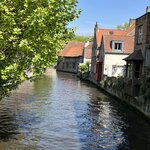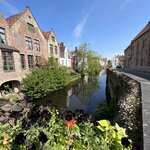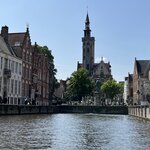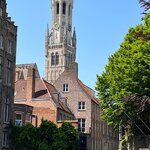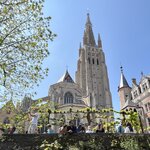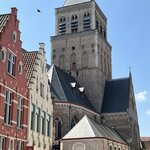Highlights
- Discover Venetian cicchetti on a tour of the city's best bacari (wine bars)
- Explore Emilia-Romagna's gastronomy with foodie tours of Bologna and Parma
- Sip Tuscany's renowned wines and sample bistecca alla Fiorentina in Florence
- Savor southern Italy's cuisine with pizza making in Amalfi and street food in Rome
Brief Itinerary
| Day | Highlights | Overnight |
|---|---|---|
| Day 1 | Arrive in Rome, Train to Venice, Canareggio Food Tour | Venice |
| Day 2 | San Polo & Rialto Market Food Tour, Free Afternoon | Venice |
| Day 3 | Train to Bologna, Food-Focused City Tour | Bologna |
| Day 4 | Day Trip to Parma, Prosciutto & Parmigiano Reggiano Tasting | Bologna |
| Day 5 | Train to Florence, Explore the Renaissance Capital | Florence |
| Day 6 | Tuscany Tour & Wine Tasting | Florence |
| Day 7 | Free Day in Florence | Florence |
| Day 8 | Transfer to the Amalfi Coast, Guided Tour of the Italian Riviera | Maiori |
| Day 9 | Marisa Cuomo Vineyard Tour & Wine Tasting | Maiori |
| Day 10 | Free Day on the Amalfi Coast | Maiori |
| Day 11 | Neapolitan Pizza Masterclass, Free Afternoon | Maiori |
| Day 12 | Train to Rome, Self-Guided City Tour | Rome |
| Day 13 | Trastevere Food & Wine Tour | Rome |
| Day 14 | Depart Rome |
Detailed Itinerary
Day 1: Arrive in Rome, Train to Venice, Canareggio Food Tour

Benvenuti in Venezia! Arrive in one of Rome's two international airports, then transfer to Termini Station to catch a high-speed train to Venice. You'll experience the city's distinctive network of canals and car-free streets with a vaporetto (water taxi) from the station to one of the central stops on the Grand Canal, located near your hotel. Check in and relax, then head out to discover the beautiful bridges, atmospheric streets, and glimmering architecture that make the elegant "City of Canals" one of Europe's top destinations.
Your first stop should be Piazza San Marco, home to the splendid Basilica San Marco and flanked on each side by two 18th-century coffee houses, Caffè Florian and Caffè Quadri. You'll pay a premium if you stop for coffee or a glass of wine at either, but it's worth it for the view of the enchanting square, described by Napoleon as "the world's most beautiful drawing room."
In the evening, head to the Cannaregio quarter for a guided food tour of the city's former Jewish Ghetto. Eat and drink your way through regional specialties as you learn about the Jewish and kosher influences while sampling cicchetti (Venetian tapas), creamy risottos, and local wines. Buon appetito!
Day 2: San Polo & Rialto Market Food Tour, Free Afternoon

See more of the city's sights this morning and savor plenty of delicious morsels with a street food tour that encompasses the San Polo neighborhood and the bustling Rialto Market. Wander the stalls gleaming with fresh produce and sparkling seafood, and you'll be part of a tradition that dates back to 1097; there's been a market at this famous sight for almost 1,000 years. Next up is a tour of the local bars to sample tramezzini (crustless sandwiches with fillings including tuna, shrimp, egg, and ham). Once your appetite's sated, you'll part ways with your guide.
Spend the rest of the day exploring under your own steam. Stroll around the Campo Santa Margherita in Venice's Dorsoduro district and see the square's 14th and 15th-century buildings. Then, visit the medieval churches, including the 13th-century Basilica dei Frari, which houses several notable artworks, including "Madonna and Child with Saints" and the "Assumption." Alternatively, spend a leisurely few hours exploring the city's canals and the palazzi (palaces) that seemingly rise up from the water with a gondola ride through the intricate network of bridges and narrow calli (streets).
In the early evening, make your way to a local bacari (Venetian wine bar) and partake in the Venetian tradition of a small glass of wine, known as an ombra, accompanied by cicchetti. Try classic combinations such as baccalà mantecato (creamy whipped salt cod), sarde in saor (sweet and sour fried sardines with raisins and pine nuts), and scampi grigliati (grilled scampi) alongside more innovative offerings like lardo (pork fat) with pecorino, rosemary, and honey or crostini topped with artichokes, ricotta, and walnuts or smoked beef and pesto.
Day 3: Train to Bologna, Food-Focused City Tour

This morning, you'll catch a 1.5-hour train southwest to Bologna, Emilia-Romagna's foodie capital. Arrive midmorning and, after checking in, head out to discover the gastronomy and historic charms of Europe's oldest university town. Start with caffè in Piazza Maggiore, the town's grand 13th-century plaza, overlooked by some of Bologna's most prominent and historic buildings. Visit the City Hall, the 14th-century Basilica di San Petronio, and the medieval Asinelli and Garisenda towers flanking the piazza.
Pause for lunch and dine on typical Bolognan cuisine, such as tagliatelle al ragù or tortelloni in brodo (tiny meat-filled pasta served in a delicate broth), accompanied by a glass of the region's excellent local wine. Afterward, explore the city via the medieval porticos, a network of covered walkways that connect the city's landmarks, museums, and neighborhoods. Stop in at the Pinacoteca Nazionale di Bologna to discover renowned 14th-century artists such as Jacopo di Paolo and Guido Reni, or for a modern take on the city's renowned art, head to the Museo d'Arte Moderna di Bologna (MAMbo).
Toward the end of the afternoon, it's time to sharpen your taste buds once more with a walking food tour where you'll explore the city's foodie hotspots with a local guide and shop for regional delicacies, such as artisanal tortellini, mortadella, and formaggi. You'll visit traditional pasticcerie (bakeries) and sample a delicious variety of sweet and savory delicacies before a trip to a local pasta maker to see the handcrafting process in action.
Day 4: Day Trip to Parma, Prosciutto & Parmigiano Reggiano Tasting

Known for its ornate medieval architecture, castles, and its famous prosciutto namesake, Parma, along with Bologna, is considered one of the top foodie destinations for travelers to northern Italy. This morning, you'll catch an hour's train to the city and meet your guide in the center. See highlights, including the 10th-century University of Parma, the Museo Glauco Lombardi, the 12th-century Piazza Duomo, and the world-renowned opera venue, Teatro Regio.
Next up, it's time to explore the local production sites of the city's two main food exports, Prosciutto Crudo di Parma and Parmigiano-Reggiano cheese, staples not just in Italian cooking but around the world. You'll learn about and see the production process in action and the hard work that goes into ensuring they meet high regional standards and the coveted DOP (Denominazione di Origine Protetta) status or PDO.
Whet your appetite with a tasting of delicious cheese, ham, and traditional balsamic vinegar, and then it's off to a local family-run trattoria for lunch. Northern Italian cooking favors ingredients such as butter, cheese, truffles, risotto rice, and polenta, so expect dishes such as risotto Milanese and ravioli al burro e salvia (ravioli with butter and sage). After you've feasted on regional specialties, spend the afternoon strolling the town before returning to Bologna in the evening.
Day 5: Train to Florence, Explore the Renaissance Capital

After breakfast, head to Bologna's station to catch a train to Florence, Tuscany's regional capital, famous for its Renaissance art and architecture. Spend the day at leisure touring the top sights, starting in the Piazza del Duomo, where the magnificent Cattedrale di Santa Maria del Fiore (Il Duomo) and its mighty terracotta dome attract visitors from all over the world. Don't miss the nearby Uffizi Gallery, which houses works by Leonardo da Vinci and Botticelli, and the Galleria dell'Academia, which displays Michelangelo's famous "David."
Florence is brimming with great eateries, so make time for a leisurely lunch and try dishes such as bistecca al Fiorentina (flame-grilled T-bone steak) and ribollita (a hearty soup made of beans, vegetables, olive oil, and bread). Afterward, wander the back streets and stop for gelato; the city has some of the region's best gelaterias with traditional and innovative flavor combinations. Alternatively, spend the afternoon on a guided walking tour of the city, where you'll be shown the best artisanal produce and off-the-beaten-path bars and cafés.
End your day in Florence with aperitivo at one of the city's elegant rooftop bars, such as Il Continentale or Hotel Lucchesi, where you can watch the sun go down and admire the city's skyline.
Chat with a local specialist who can help organize your trip.
Day 6: Tuscany Tour & Wine Tasting

This morning, you'll embark on a tour of the gorgeous Tuscan countryside and towns dotted along the rolling hills outside Florence. Admire the landscape filled with olive groves, cypress trees, and farms as you approach one of the region's gems—the medieval village of San Gimignano. This UNESCO World Heritage Site is known for its 14th-century Torre Grossa, which, at 177 feet (54 m), stands as the tallest of the town's 14 towers. Explore the beautiful squares and stop for award-winning gelato in Piazza della Cisterna or a glass of local Vernaccia di San Gimignano white wine.
Your next stop is a winery in the Chianti Hills, where you'll tour the vineyards and cellars behind the region's eponymous wine. Made from a minimum of 80% sangiovese grapes, Chianti Classico is produced from vineyards within a distinct area that stretches between the cities of Florence and Siena. Learn about the centuries-old production process and then sit down to a tasting of various vintages accompanied by a typical Tuscan lunch of cured meats, cheeses, a primo (usually a pasta course), and a choice of dolce (dessert).
After lunch, you'll visit nearby Siena and tour the town's Duomo, a magnificent Romanesque-Gothic cathedral known for its intricate marble inlay floor and treasures, including works by Bernini, Pisano, and Donatello. Roam the narrow cobbled backstreets until you reach the vast Piazza del Campo, the town's central square and site of the famous Palio di Siena horse race. It's a great spot for an aperitivo and to catch a breather before you finish the day with a visit to the medieval fortress of Monteriggioni and head back to Florence for the evening.
Day 7: Free Day in Florence

It's your last day in Florence, and yours to explore the city at your leisure. Head over to the Mercado di San Lorenzo, where you can grab a midmorning pastry and espresso and spend an hour or two soaking up the atmosphere and browsing the stalls. You'll find plenty to catch your eye with the various artisanal leather goods the city is famed for, alongside pottery, beautiful notebooks, jewelry, and much more. When you're feeling peckish, head inside to the Mercado Centrale, where you'll find all the food stalls and plenty of options for a great lunch.
In the afternoon, wander over to Piazza della Republica and pause for refreshments at one of the historic cafés that line the square. Continue to Il Ponte Vecchio, a medieval stone bridge with an array of jewelry shops and beautiful views along the River Arno. As the sun starts to dip, end your day with a visit to Piazzale Michelangelo. It's an uphill walk (or you can catch a cab or bus), but you'll be rewarded with splendid sunset views across the whole of Florence and the rolling Tuscan countryside.
Day 8: Transfer to the Amalfi Coast, Guided Tour of the Italian Riviera

Wave goodbye to Florence this morning and catch a high-speed train to Naples. It's just under a three-hour journey, so sit back and relax as you zip through the regions of Tuscany and Lazio until you reach Campania and its capital. Upon arrival, you'll meet your driver and transfer to your hotel on the Amalfi Coast.
Spend the rest of the day discovering the towns and hilltop villages nestled along the coast with a private guided tour. Your first stop is Positano, whose beautiful beaches and tumbling pastel-hued houses attract visitors worldwide. Stroll the steep cobbled streets and alleyways covered in fuchsia bougainvillea and hop back in the car to the coast's namesake of Amalfi, passing the beautiful villages of Praiano and Conca dei Marini along the way.
Wander the town to discover the region's local crafts and artisanal produce, and tour the Duomo di Sant'Andrea, Amalfi's ninth-century Roman Catholic cathedral. Pause for gelato and soak up the views of the colorful houses perched within the rocky cliffs before continuing to Ravello, your last destination. Visit one of the town's star attractions, the 13th-century Villa Rufolo, overlooking the Piazza Vescovado and known for its panoramic terrace and gardens. You'll end your tour with lunch at a local restaurant with enchanting views.
Day 9: Marisa Cuomo Vineyard Tour & Wine Tasting

Today you'll set off on a tour of the Mariso Cuomo Winery in Furore, known locally as "the town that doesn't exist." Set above a fjord with a sprinkling of cottages clinging to the rock face, the tiny town's dramatic location and steep slopes, combined with the sunny weather and warm winds from the Gulf of Salerno, create ideal vineyard conditions. Visit the estate's cellars (uniquely placed within the cliff face) and learn about the traditional techniques and innovative methods which has earned the winery both national and international recognition.
You'll finish the tour with a tasting of the vineyard's red, white, and rosé wines, accompanied by a selection of locally produced formaggi and salume. The rest of the afternoon is yours to explore at leisure. Spend a couple of hours admiring the Greek Doric temples at the Paestum Archaeological Park, around 1.5 hours south of Amalfi, or soak up the rays at Arienzo Beach in Positano. Nearby Praiano is a great option for those wanting to experience the coast's inviting waters, with plenty of windsurfing, watersports, and kayaking options.
Day 10: Free Day on the Amalfi Coast

Today is yours to do as little or as much as you'd like. Start the day with a walk along the area's famous Lemon Path, a moderate 2-mile (3 km) walk that stretches from Maiori to Minori, where you'll encounter bougainvillea-strewn houses, pretty churches, sea views, and an abundance of lemon groves. Alternatively, hike the Sentiero degli Dei (Path of the Gods), the coast's famous walk known for its wonderful views over Positano and the Sorrento Peninsula.
Afterward, enjoy a well-earned lunch at a local restaurant and soak up the relaxed coastal vibe while sampling plates of fresh seafood. Spend the rest of the afternoon relaxing on the beaches at Gavitella in Vettica Maggiore or Castiglione di Ravello. Otherwise, board one of the regular boat tours from the nearby fishing village of Conca dei Marini for a trip to the Grotta dello Smeraldo. The glittering cave with serene turquoise waters is a good escape from the midday sun, and the town's jumble of white houses tucked into the rocks make for a picturesque spot to enjoy an aperitivo.
Day 11: Neapolitan Pizza Masterclass, Free Afternoon

No foodie trip to the Amalfi Coast is complete without a taste of authentic Neapolitan pizza, and today, you'll master the art of southern Italy's classic dish. Led by a professional pizzaiolo (pizza chef), learn how to craft the perfect pizza using local ingredients and traditional techniques. With your creations freshly out of the wood-fired oven, you'll dine with your fellow chefs and add "Neapolitan pizza maker" to your cooking repertoire.
Spend your last afternoon on the coast exploring any attractions you've not yet had a chance to see. Walk off the delicious pizza with a hike on the well-known route from Atrani to Ravello, admiring the citrus groves and pausing for gelato along the way. For a slightly less strenuous option, consider the Amalfi Natural Reserve Valle delle Ferriere, a lovely oasis with plenty of shade, ruins of old mills, ancient ironworks, and tiny waterfalls.
Day 12: Train to Rome, Self-Guided City Tour

Enjoy one last lingering glance at the Amalfi Coast this morning before catching a high-speed train to Rome. Check in at your hotel, and the rest of the day is yours to explore the "Eternal City" and discover the ancient ruins, art, culture, and food scene that draws millions of tourists each year. First-time visitors shouldn't leave without seeing the Colosseum, the city's iconic amphitheater built by Flavian emperors that served as the epicenter of Rome's public entertainment.
The nearby Foro Romana (Roman Forum) is a must for history buffs, with a vast archaeological site comprising the fascinating ruins of the temples, squares, and religious sites that witnessed some of the Roman Empire's key political spectacles, including the downfall of Julius Caesar. Spend the afternoon wandering the 45 galleries of the Vatican Museum and admiring the frescoed ceiling of the Sistine Chapel and Bernini's celebrated Piazza San Pietro.
As dusk falls, head to Gianicolo Hill to see the sunset and the twinkling St. Peter's Dome. In the evening, dine at Armando al Pantheon, a Roman institution, moments from the historic temple. Finish with a nightcap in the Piazza Navona before seeing the Trevi Fountain, whose illuminated Baroque carvings are even more stunning at nightfall.
Day 13: Trastevere Food & Wine Tour

Spend your last day eating and drinking your way through Rome's phenomenal food scene with a guided food tour. You'll start in the bustling Piazza Campo de' Fiori, known for its open-air market and plethora of food stalls. Shop for local cheeses, cured meats, fresh vegetables, and plenty of artisanal produce from Lazio. Then, head over the river to the charming wisteria-filled Trastevere neighborhood. Try a variety of Roman street food specialties such as supplì, pizza bianca filled with stracciatella, mortadella, and pistachios, and porchetta (roast pork stuffed and rolled with herbs).
Finish your tour in Trastevere's Piazza di Santa Maria, a lively square and meeting point filled with locals and the perfect spot to enjoy a gelato. In the evening, you'll be spoiled for choice with great dining options. Start with an aperitivo in a neighborhood piazza and wrap up the night feasting on one of the four famous Roman pasta dishes: alla carbonara, alla gricia, cacio e pepe, or all'amatriciana.
Day 14: Depart Rome

Say goodbye, or ciao, to Italy for now. Take advantage of any extra time with one last morning stroll around Rome before transferring to the airport, where you'll catch your flight home or continue your European adventure. Safe travels!
More Great Italy Itineraries
Looking for more inspiration for your trip to Italy? Check out these other Italy itineraries, explore different ways to spend two weeks in Italy indulging in food and wine, or discover the best time to visit Italy.



